Optimal Operation of Hydropower Reservoirs under Climate Change: The Case of Tekeze Reservoir, Eastern Nile
Abstract
:1. Introduction
2. Material and Methods
2.1. Study Area
2.2. Datasets Used
2.2.1. Historical and Future Hydrology
2.2.2. CORDEX-Africa
2.2.3. Reservoir Data
2.3. Methods
2.3.1. Overview of SWAT
2.3.2. HEC-ResPRM Optimization Model
3. Results and Discussions
3.1. Climate Projections
3.2. Impacts of Climate Change on Streamflow
3.3. Current Reservoir Operation
3.4. Reservoir Operation under Climate Change
3.4.1. Projected Reservoir Inflow and Outflow
3.4.2. Optimum Reservoir Power Storage under Climate Change
3.4.3. Optimum Reservoir Pool Level (Elevation) under Climate Change
4. Conclusions
- This study found that the impact of climate change would increase in precipitation, temperature and streamflow in Tekeze basin under RCP4.5 and RCP8.5 climate scenarios over future periods which have an impact on current and future Tekeze hydropower reservoir operation.
- Projected annual and inter-annual reservoir inflow showed increasing trend under both RCP4.5 and RCP8.5 climate scenarios.
- HEC-ResPRM incorporates water storage, water surface elevation, release and power generation would provide better understanding of current and future conditions of Tekeze hydropower reservoir operation.
- Current optimized power storage and pool level show more optimal results than the current actual operation, so it is recommended to change the current operating policy to produce more power throughout the year.
- The projected increase of reservoir inflow under an ensemble of CORDEX-Africa RCP4.5 and RCP8.5 future climate scenarios lead to optimized reservoir power storage, pool level (head) and release that greatly exceed those historically observed, indicating a shift in current water system behavior.
- The study showed that climate change clearly affects future reservoir planning and management in Tekeze basin. Therefore, water resources planners, managers and operators should consider climate change impacts in the design, planning and management of reservoir systems.
- In practice, many reservoir system operators and water managers feel more comfortable to use pre-defined rule curves and simulation results which are easy to understand and operate as most optimal operating rules developed by scientists using sophisticated optimization models and algorithms are mathematically more complex. The use of a combination of simulation and optimization models may solve this problem.
- This study has not considered the changes in land use/land cover due to socio-economic development in the future. Coupling climate models with projected changes in land use associated with climate change impacts and effect of climate change adaptation on erosion and sediment yield which is necessary to evaluate projected changes in runoff associated with future Tekeze River basin development. Hence, further studies are recommended to quantify future change in streamflow and sedimentation load in Tekeze hydropower reservoir as well as its implication on future hydropower generation.
Acknowledgements
Author Contributions
Conflicts of Interest
References
- Zhou, Y.; Guo, S.; Duan, W.; Chen, H.; Liu, P. Dynamic control of flood limited water level for cascade reservoirs. J. Hydroelectr. Eng. 2015, 34, 23–30. [Google Scholar]
- Yazdi, J.; Moridi, A. Interactive reservoir-watershed modeling framework for integrated water quality management. Water Resour. Manag. 2017, 31, 2105–2125. [Google Scholar] [CrossRef]
- Birhanu, K.; Alamirew, T.; Dinka, M.O.; Ayalew, S.; Aklog, D. Optimizing reservoir operation policy using chance constraint nonlinear programming for Koga Irrigation Dam, Ethiopia. Water Resour. Manag. 2014, 28, 4957–4970. [Google Scholar] [CrossRef]
- Rani, D.; Moreira, M.M. Simulation–optimization modeling: A survey and potential application in reservoir systems operation. Water Resour. Manag. 2010, 24, 1107–1138. [Google Scholar] [CrossRef]
- David, S.; Randolph, B.; Upali, A. Water scarcity in the Twenty-first century. Int. J. Water Resour. Dev. 1999, 15, 29–42. [Google Scholar] [CrossRef]
- Jury, W.A.; Henry, J.V.J. The emerging global water crisis: Managing scarcity and conflict between water users. Adv. Agron. 2007, 95, 1–76. [Google Scholar]
- Rijsberman, G. Water scarcity: Fact or fiction? Agric. Water Manag. 2006, 80, 5–22. [Google Scholar] [CrossRef]
- Larson, K.L.; Polsky, C.; Gober, P.; Chang, H.; Shandas, V. Vulnerability of water systems to the effects of climate change and urbanization: A comparison of Phoenix, Arizona and Portland, Oregon (USA). Environ. Manag. 2013, 52, 179–195. [Google Scholar] [CrossRef] [PubMed]
- Ghashghaie, M.; Marofi, S.; Marofi, H. Using system dynamics method to determine the effect of water demand priorities on downstream flow. Water Resour. Manag. 2014, 28. [Google Scholar] [CrossRef]
- Guo, S.; Chen, J.; Li, Y.; Liu, P.; Li, T. Joint operation of the multi-reservoir system of the Three Gorges and the Qingjiang Cascade Reservoirs. Energies 2011, 4, 1036–1050. [Google Scholar] [CrossRef]
- Zhou, Y.; Guo, S.; Liu, P.; Xu, C. Joint operation and dynamic control of flood limiting water levels for mixed cascade reservoir systems. J. Hydrol. 2014, 519, 248–257. [Google Scholar] [CrossRef]
- Azizipour, M.; Ghalenoei, V.; Afshar, M.H.; Solis, S.S. Optimal operation of hydropower reservoir systems using weed optimization algorithm. Water Resour. Manag. 2016, 30, 3995–4009. [Google Scholar] [CrossRef]
- He, Y.; Xu, Q.; Yang, S.; Liao, L. Reservoir flood control operation based on chaotic particle swarm optimization algorithm. Appl. Math. Model. 2014, 38, 4480–4492. [Google Scholar] [CrossRef]
- Lu, B.; Li, K.; Zhang, H.; Wang, W.; Gu, H. Study on the optimal hydropower generation of Zhelin reservoir. J. Hydro-Environ. Res. 2013, 7, 270–278. [Google Scholar] [CrossRef]
- Cheng, C.-T.; Wang, W.-C.; Xu, D.-M.; Chau, K.W. Optimizing hydropower reservoir operation using hybrid genetic algorithm and chaos. Water Resour. Manag. 2008, 22, 895–909. [Google Scholar] [CrossRef]
- Yin, X.A.; Yang, Z.F. Development of a coupled reservoir operation and water diversion model: Balancing human and environmental flow requirements. Ecol. Model. 2011, 222, 224–231. [Google Scholar] [CrossRef]
- Milly, P.; Betancourt, J.; Falkenmark, M.; Hirsch, R.M.; Kundzewicz, W.Z.; Lettenmaier, P.D.; Stouffer, R.J. Stationarity is dead: Whither water management? Science 2008, 319, 573–574. [Google Scholar] [CrossRef] [PubMed]
- Stocker, D.; Qin, G.-K.; Plattner, L.V.; Allen, S.K. Technical summary. In Climate Change 2013: The Physical Science Basis. Contribution of Working Group I to the Fifth Assessment Report of the Intergovernmental Panel on Climate Change; Cambridge University Press: Cambridge, UK, 2013; pp. 31–116. ISBN 978-1-107-41532-4. [Google Scholar]
- Huntington, T.G. Climate warming-induced intensification of the hydrologic cycle: An assessment of the published record and potential impacts on agriculture. In Advances in Agronomy; Sparks, D.L., Ed.; Academic Press: Cambridge, MA, USA, 2010; Volume 109, pp. 1–53. [Google Scholar]
- Vicuña, S.; Garreaud, R.D.; McPhee, J. Climate change impacts on the hydrology of a snowmelt driven basin in semiarid Chile. Clim. Chang. 2011, 105, 469–488. [Google Scholar] [CrossRef]
- Alazzy, A.; Lü, H.; Zhu, Y. Impact of climate change on evaluation of future water demand in the Euphrates and Aleppo basin, Syria. Proc. Int. Assoc. Hydrol. Sci. 2014, 364, 307–312. [Google Scholar] [CrossRef]
- Zhang, C.; Zhu, X.; Fu, G.; Zhou, H.; Wang, H. The impacts of climate change on water diversion strategies for a water deficit reservoir. J. Hydroinform. 2014, 16, 872–889. [Google Scholar] [CrossRef]
- Lumbroso, D.M.; Woolhouse, G.; Jones, L. A review of the consideration of climate change in the planning of hydropower schemes in sub-Saharan Africa. Clim. Chang. 2015, 133, 621–633. [Google Scholar] [CrossRef]
- Lee, S.-Y.; Hamlet, A.F.; Grossman, E.E. Impacts of climate change on regulated streamflow, hydrologic extremes, hydropower production, and sediment discharge in the Skagit River Basin. Northwest Sci. 2016, 90, 23–43. [Google Scholar] [CrossRef]
- Setegn, S.; Melesse, A.; Haiduk, A.; Webber, D.; Wang, X.; McClain, M. Modeling hydrological variability of fresh water resources in the Rio Cobre watershed, Jamaica. Catena 2014, 120, 81–90. [Google Scholar] [CrossRef]
- Ehsani, N.; Vörösmarty, C.J.; Fekete, B.M.; Stakhiv, E.Z. Reservoir operations under climate change: Storage Capacity options to mitigate risk. J. Hydrol. 2017, 555, 435–446. [Google Scholar] [CrossRef]
- Haile, A.T.; Akawka, A.L.; Berhanu, B.; Rientjes, T. Changes in water availability in the Upper Blue Nile Basin under the representative concentration pathways scenario. Hydrol. Sci. J. 2017, 62, 2139–2149. [Google Scholar] [CrossRef]
- Zhu, X.; Zhang, C.; Qi, W.; Cai, W.; Zhao, X.; Wang, X. Multiple climate change scenarios and runoff response in Biliu River. Water 2018, 10, 126. [Google Scholar] [CrossRef]
- Serdeczny, O.; Adams, S.; Baarsch, F.; Coumou, D.; Robinson, A.; Hare, W.; Schaeffer, M.; Perrette, M.; Reinhardt, J. Climate change impacts in Sub-Saharan Africa: From physical changes to their social repercussions. Reg. Environ. Chang. 2017, 17, 1585–1600. [Google Scholar] [CrossRef]
- Conway, D.; Persechino, A.; Ardoin-Bardin, S.; Hamandawana, H.; Dieulin, C.; Mahé, G. Rainfall and water resources variability in Sub-Saharan Africa during the twentieth century. J. Hydrometeorol. 2009, 10, 41–59. [Google Scholar] [CrossRef]
- Hales, S. Contribution of Working Group II to the Fourth Assessment Report of the Intergovernmental Panel on Climate Change; Climate Change 2007: Impacts, Adaptation and Vulnerability; Parry, M.L., Canziani, O.F., Palutikof, J.P., van der Linden, P.J., Hanson, C.E., Eds.; Cambridge University Press: Cambridge, UK, 2007. [Google Scholar]
- Nikulin, G.; Jones, C.; Giorgi, F.; Asrar, G.; Büchner, M.; Cerezo-Mota, R.; Christensen, O.B.; Déqué, M.; Fernandez, J.; Hänsler, A.; et al. Precipitation climatology in an ensemble of CORDEX-Africa regional climate simulations. J. Clim. 2012, 25, 6057–6078. [Google Scholar] [CrossRef]
- Kim, U.; Kaluarachchi, J.J. Climate change impacts on water resources in the Upper Blue Nile River Basin, Ethiopia. JAWRA J. Am. Water Resour. Assoc. 2009, 45, 1361–1378. [Google Scholar] [CrossRef]
- Beyene, T.; Lettenmaier, D.P.; Kabat, P. Hydrologic impacts of climate change on the Nile River Basin: implications of the 2007 IPCC scenarios. Clim. Chang. 2010, 100, 433–461. [Google Scholar] [CrossRef]
- Yamba, F.D.; Walimwipi, H.; Jain, S.; Zhou, P.; Cuamba, B.; Mzezewa, C. Climate change/variability implications on hydroelectricity generation in the Zambezi River Basin. Mitig. Adapt. Strateg. Glob. Chang. 2011, 16, 617–628. [Google Scholar] [CrossRef]
- Hamududu, B.H.; Killingtveit, Å. Hydropower production in future climate scenarios; the case for the Zambezi River. Energies 2016, 9, 502. [Google Scholar] [CrossRef]
- Abtew, W.; Melesse, A.M.; Dessalegne, T. Spatial, inter and intra-annual variability of the Upper Blue Nile Basin rainfall. Hydrol. Process. 2009, 23, 3075–3082. [Google Scholar] [CrossRef]
- Mengistu, D.; Bewket, W.; Lal, R. Recent spatiotemporal temperature and rainfall variability and trends over the Upper Blue Nile River Basin, Ethiopia. Int. J. Climatol. 2014, 34, 2278–2292. [Google Scholar] [CrossRef]
- Tarekegn, D.; Tadege, A. Assessing the Impact of Climate Change on the Water Resources of the Lake Tana Basin Using the WATBAL Model; CEEPA (the Centre for Environmental Economics and Policy in Africa): Pretoria, South Africa, 2006. [Google Scholar]
- Melesse, A.M.; Loukas, A.G.; Senay, G.; Yitayew, M. Climate change, land-cover dynamics and ecohydrology of the Nile River Basin. Hydrol. Process. 2009, 23, 3651–3652. [Google Scholar] [CrossRef]
- Setegn, S.G.; Rayner, D.; Melesse, A.M.; Dargahi, B.; Srinivasan, R. Impact of climate change on the hydroclimatology of Lake Tana Basin, Ethiopia. Water Resour. Res. 2011, 47, W04511. [Google Scholar] [CrossRef]
- Jamali, S.; Abrishamchi, A.; Madani, K. Climate change and hydropower planning in the Middle East: implications for Iran’s Karkheh hydropower systems. J. Energy Eng. 2013, 139, 153–160. [Google Scholar] [CrossRef]
- Vonk, E.; Xu, Y.; Booij, M.; Zhang, X.; Augustijn, D.C.M. Adapting multireservoir operation to shifting patterns of water supply and demand. Water Resour. Manag. 2014, 28, 625–643. [Google Scholar] [CrossRef]
- Wilby, R.L.; Harris, I. A framework for assessing uncertainties in climate change impacts: Low-flow scenarios for the River Thames, UK. Water Resour. Res. 2006, 42, W02419. [Google Scholar] [CrossRef]
- Raje, D.; Mujumdar, P.P. Reservoir performance under uncertainty in hydrologic impacts of climate change. Adv. Water Resour. 2010, 33, 312–326. [Google Scholar] [CrossRef]
- Haregeweyn, N.; Poesen, J.; Nyssen, J.; Gerared, G.; Verstraeten, G.; de Vente, J.; Deckers, L.; Moeversons, J.; Haile, M. Sediment yield variability in Northern Ethiopia: A quantitative analysis of its controlling factors. Catena 2008, 75, 65–76. [Google Scholar] [CrossRef]
- Wolde, E. Identification and prioritization of sub watersheds for land and water management in Tekeze Dam watershed, Northern Ethiopia. Int. Soil Water Conserv. Res. 2016, 4, 30–38. [Google Scholar] [CrossRef]
- Wurbs, R.A. Reservoir-system simulation and optimization models. J. Water Resour. Plan. Manag. 1993, 119, 455–472. [Google Scholar] [CrossRef]
- Oliveira, R.; Loucks, D.P. Operating rules for multireservoir systems. Water Resour. Res. 1997, 33, 839–852. [Google Scholar] [CrossRef]
- Labadie, J.W. Optimal operation of multireservoir systems: State-of-the-art review. J. Water Resour. Plan. Manag. 2004, 130, 93–111. [Google Scholar] [CrossRef]
- Yeh, W.W.-G. Reservoir management and operations models: A state-of-the-art review. Water Resour. Res. 1985, 21, 1797–1818. [Google Scholar] [CrossRef]
- Ayalew, L. The effect of seasonal rainfall on landslides in the highlands of Ethiopia. Bull. Eng. Geol. Environ. 1999, 58, 9–19. [Google Scholar] [CrossRef]
- Van Vuuren, D.P.; Edmonds, J.; Kainuma, M.; Riahi, K.; Thomson, A.; Hibbard, K.; Hurtt, G.C.; Kram, T.; Krey, V.; Lamarque, J.-F.; et al. The representative concentration pathways: An overview. Clim. Chang. 2011, 109. [Google Scholar] [CrossRef]
- Meinshausen, M.; Smith, S.J.; Calvin, K.; Daniel, J.S.; Kainuma, M.L.T.; Lamarque, J.-F.; Matsumoto, K.; Montzka, S.A.; Raper, S.C.B.; Riahi, K.; et al. The RCP greenhouse gas concentrations and their extensions from 1765 to 2300. Clim. Chang. 2011, 109, 213. [Google Scholar] [CrossRef]
- Taylor, K.E.; Stouffer, R.J.; Meehl, G.A. An overview of CMIP5 and the Experiment design. Bull. Am. Meteorol. Soc. 2011, 93, 485–498. [Google Scholar] [CrossRef]
- Thomson, A.M.; Calvin, K.V.; Smith, S.J.; Kyle, P.G.; Volke, A.; Patel, P.; Delgado-Arias, S.; Bond-Lamberty, B.A.; Wise, M.A.; Clarke, L.E.; et al. RCP4.5: A pathway for stabilization of radiative forcing by 2100. Clim. Chang. 2011, 109, 77–94. [Google Scholar] [CrossRef]
- Riahi, K.; Rao, S.; Krey, V.; Cho, C.; Chirkov, V.; Fischer, G.; Kindermann, G.; Nakicenovic, N.; Rafaj, P. RCP8.5—A scenario of comparatively high greenhouse gas emissions. Clim. Chang. 2011, 109, 33. [Google Scholar] [CrossRef]
- Neitsch, S.; Arnold, J.; Kiniry, J.R.; Williams, J.R.; King, K. SWAT theoretical documentation. Grassland 2005, 494, 234–235. [Google Scholar]
- Van Griensven, A.; Ndomba, P.; Yalew, S.; Kilonzo, F. Critical review of SWAT applications in the Upper Nile Basin countries. Hydrol. Earth Syst. Sci. 2012, 16, 3371–3381. [Google Scholar] [CrossRef]
- Dessie, M.; Verhoest, N.E.C.; Admasu, T.; Pauwels, V.R.N.; Poesen, J.; Adgo, E.; Deckers, J.; Nyssen, J. Effects of the floodplain on river discharge into Lake Tana (Ethiopia). J. Hydrol. 2014, 519, 699–710. [Google Scholar] [CrossRef]
- Faber, B.A.; Harou, J.J. Multiobjective optimization with HEC Res-PRM ? Application to the Upper Mississippi Reservoir system. Oper. Reserv. Chang. Cond. 2006. [Google Scholar] [CrossRef]
- Ostadrahimi, L.; Mariño, M.A.; Afshar, A. Multi-reservoir operation rules: Multi-swarm PSO-based optimization approach. Water Resour. Manag. 2012, 26, 407–427. [Google Scholar] [CrossRef]
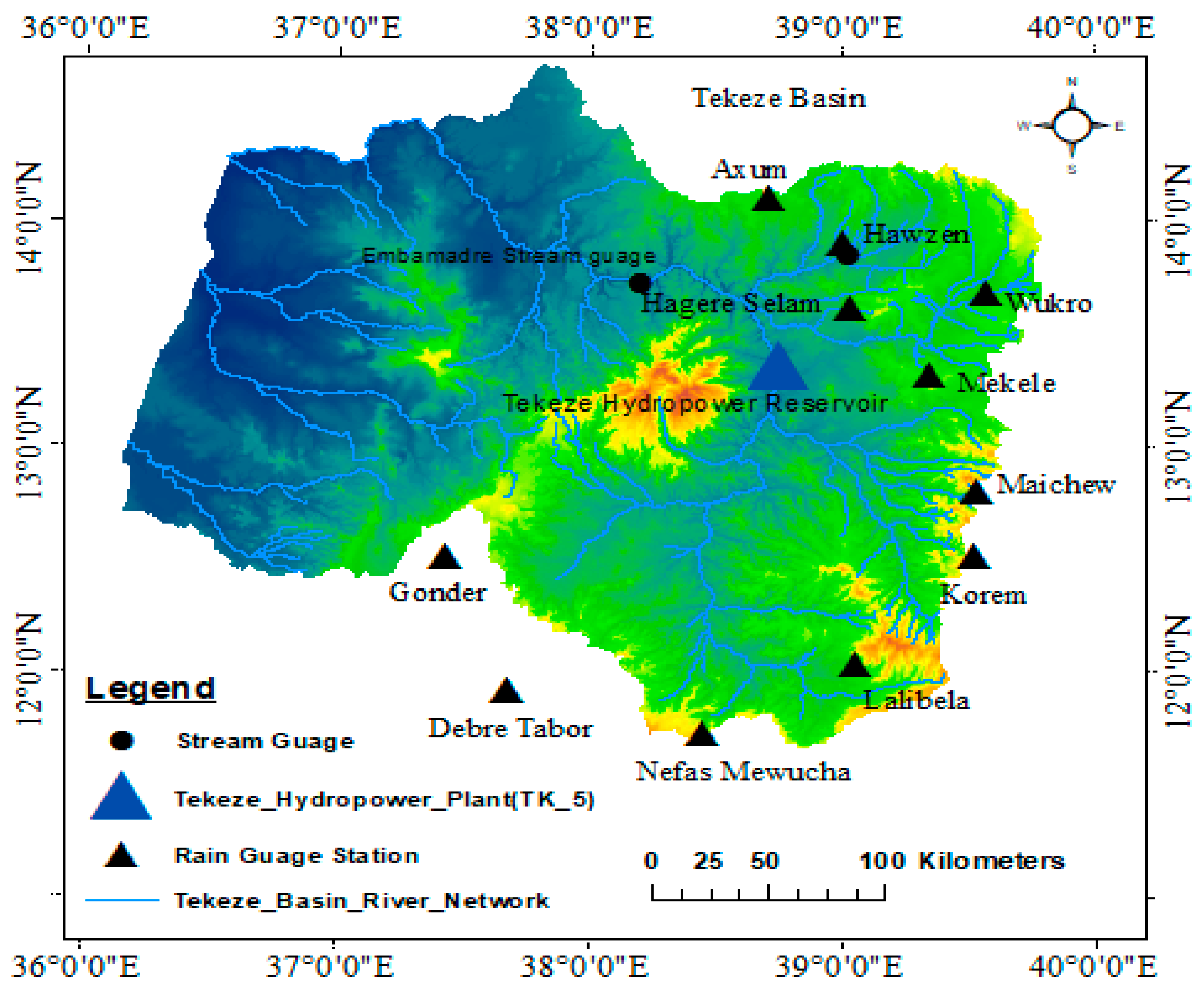
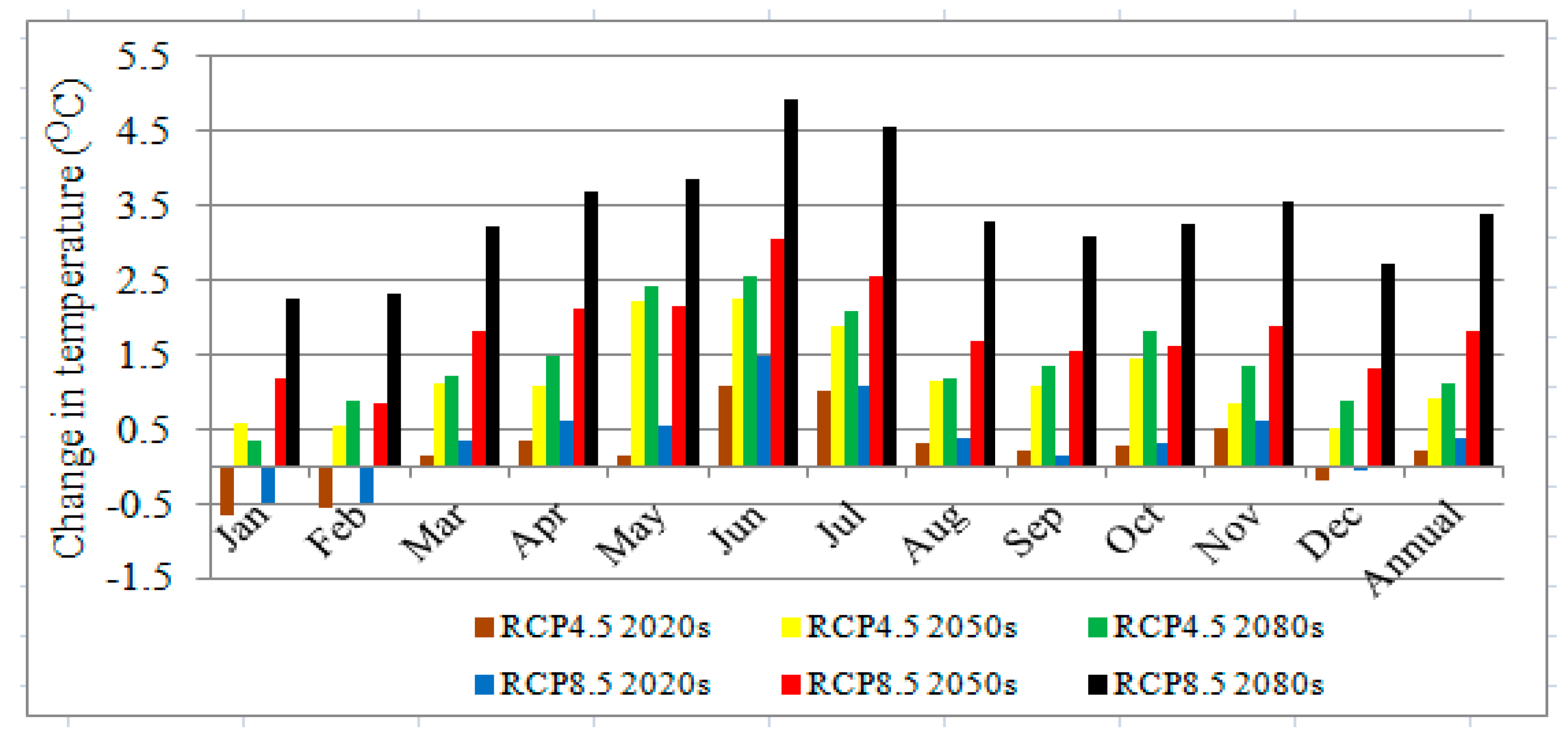


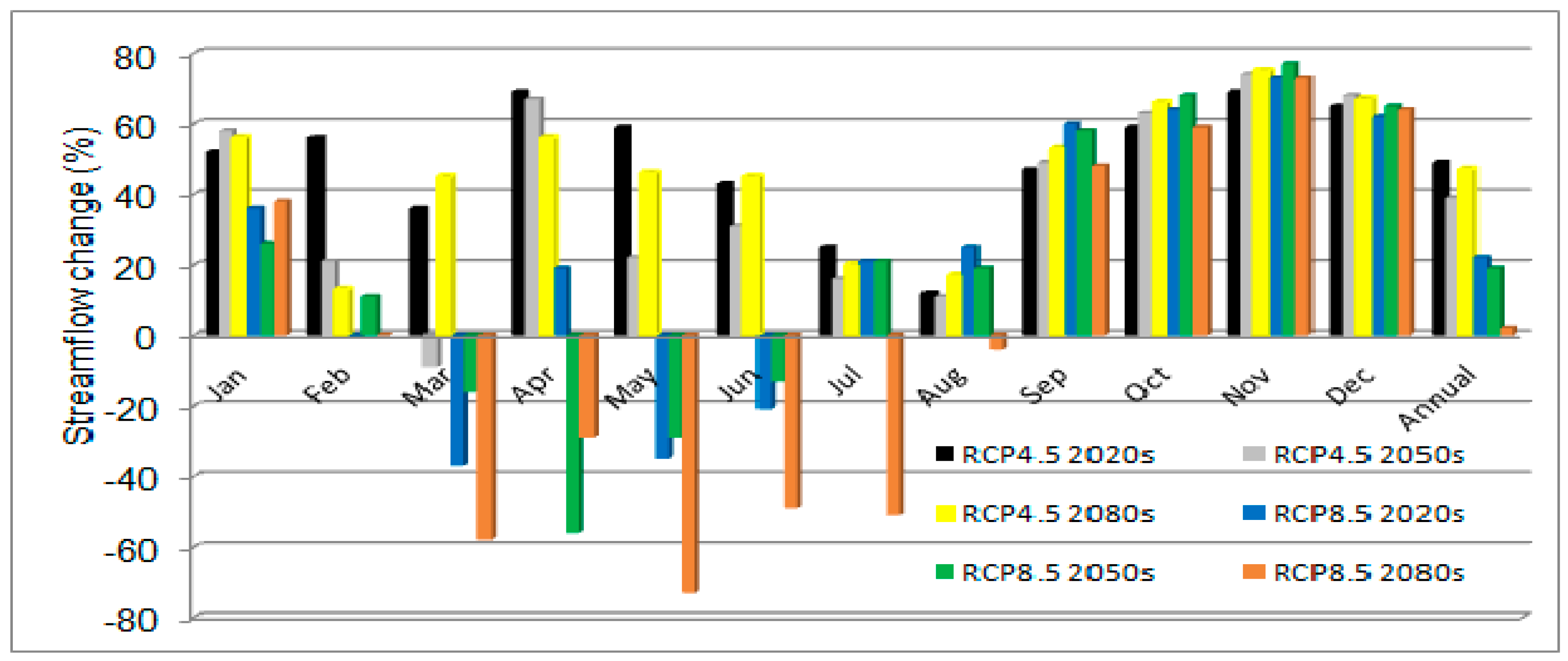
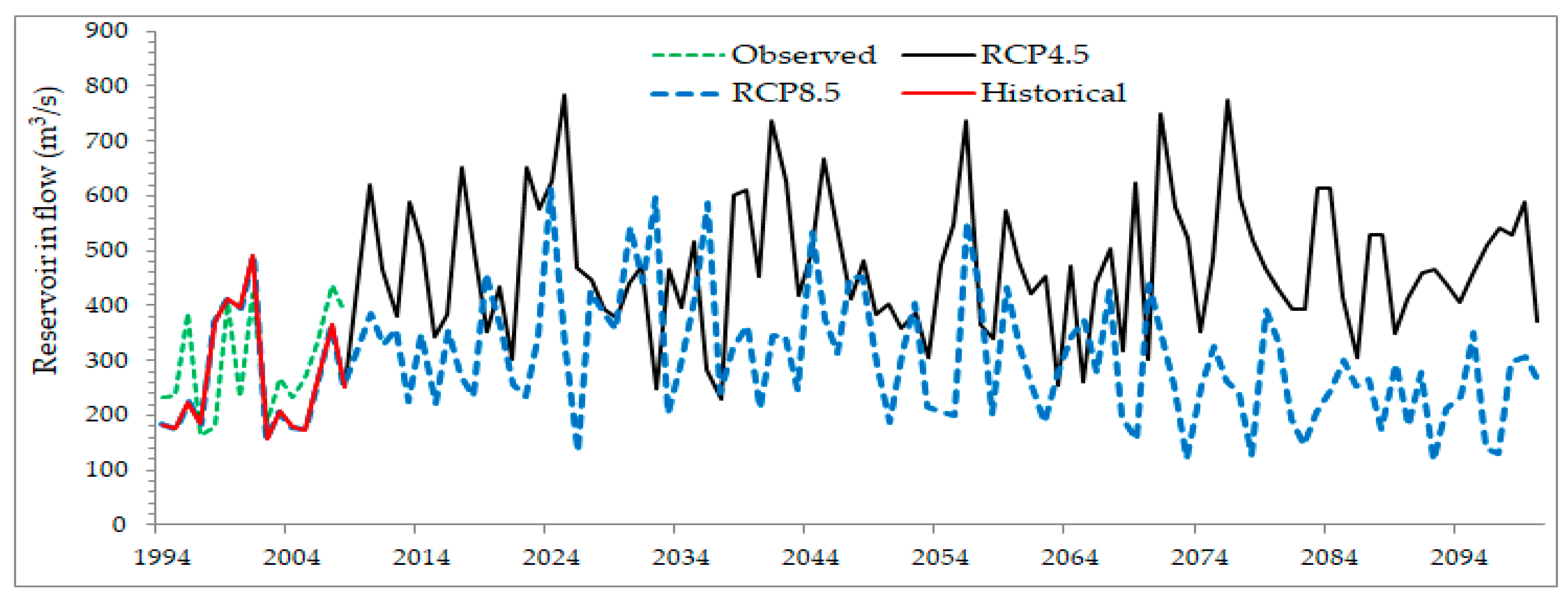
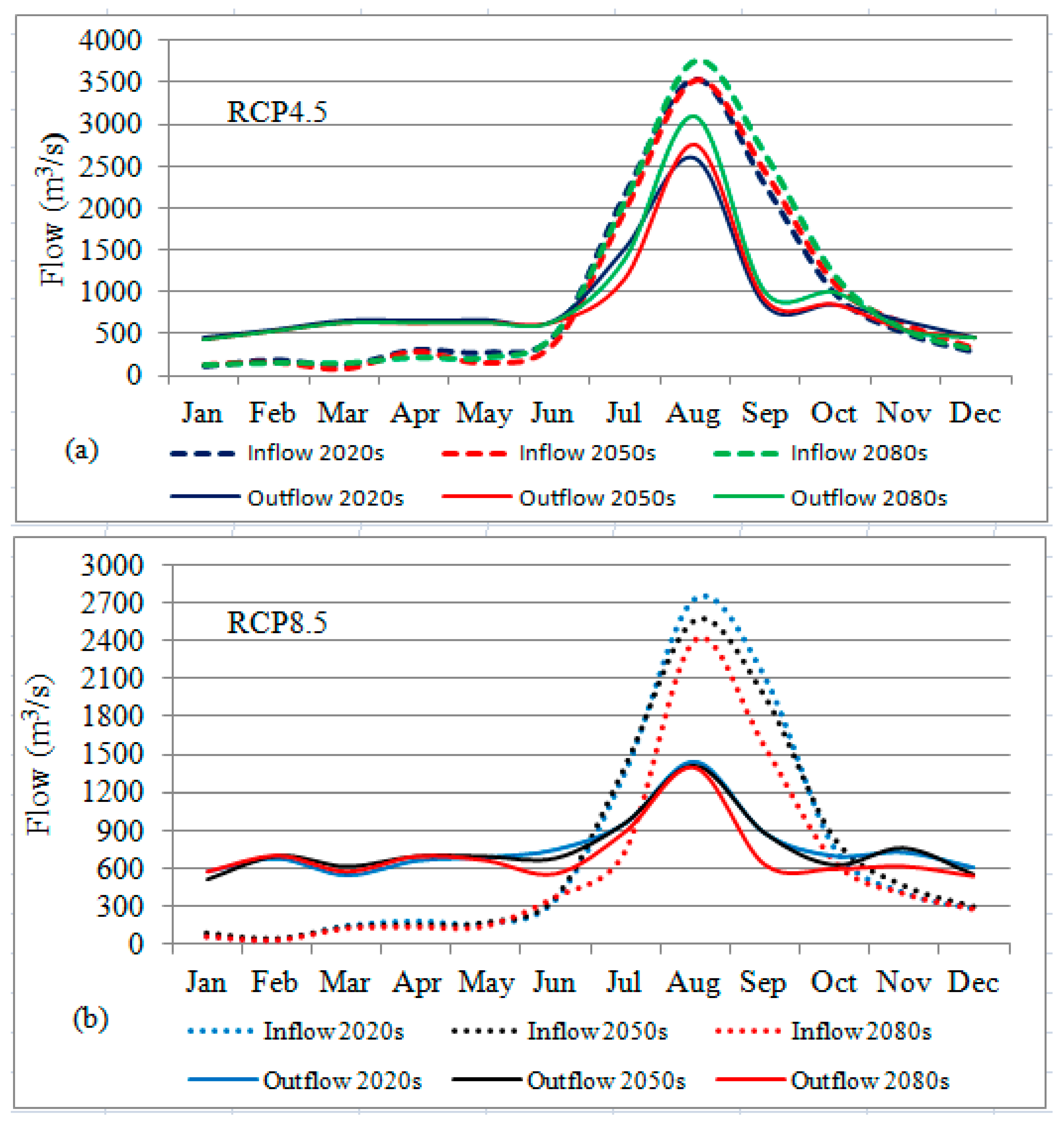
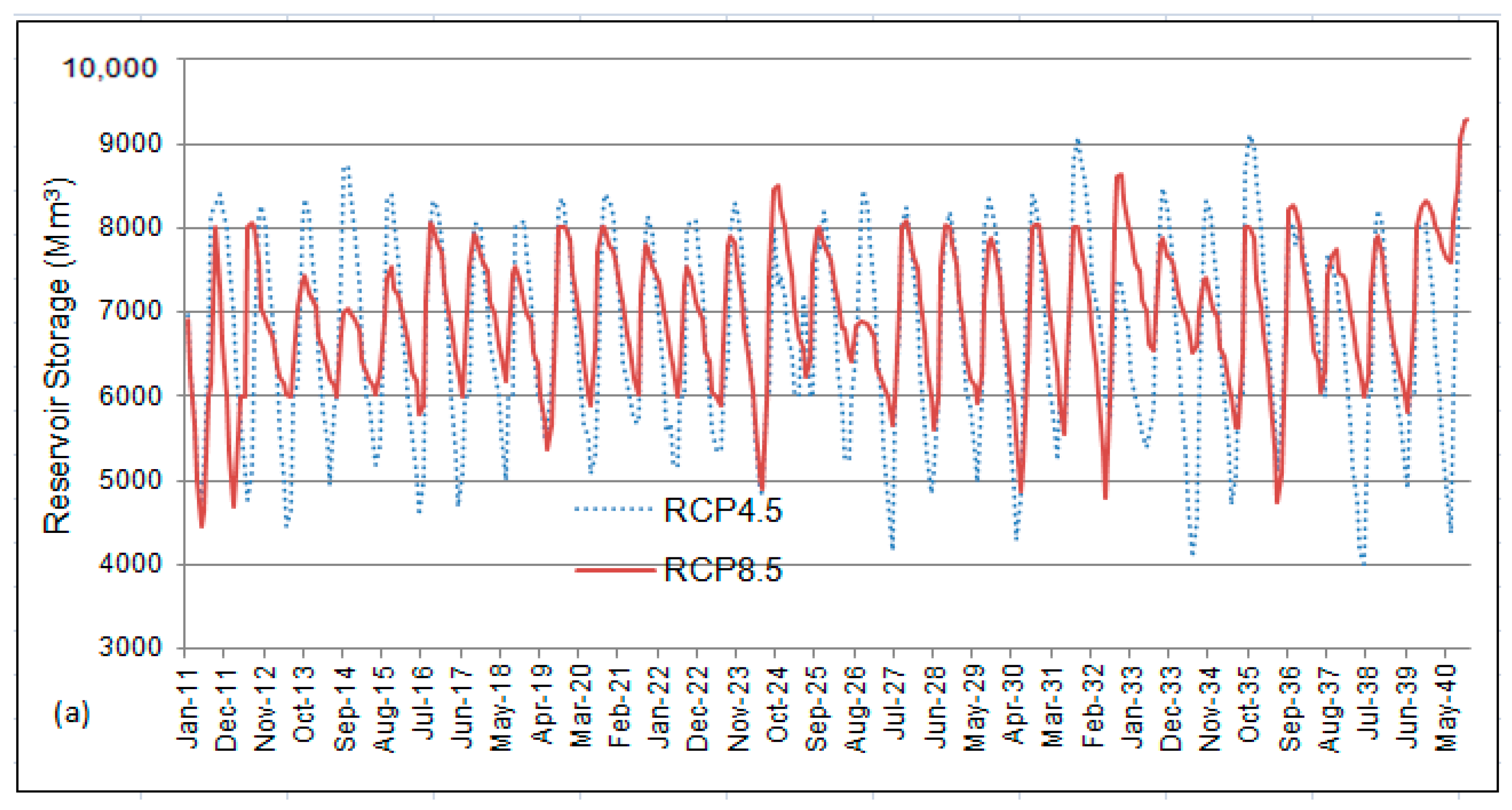
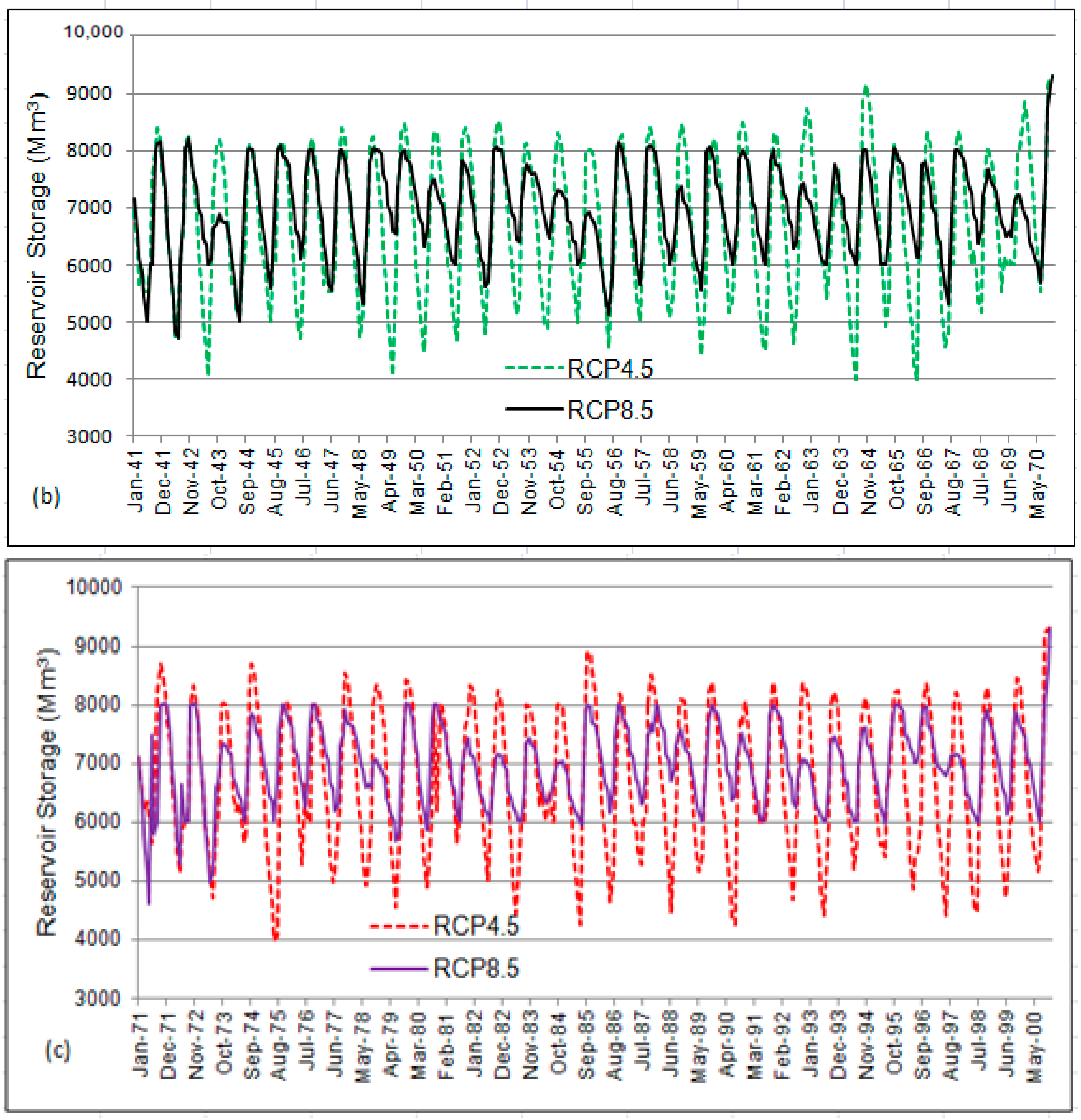
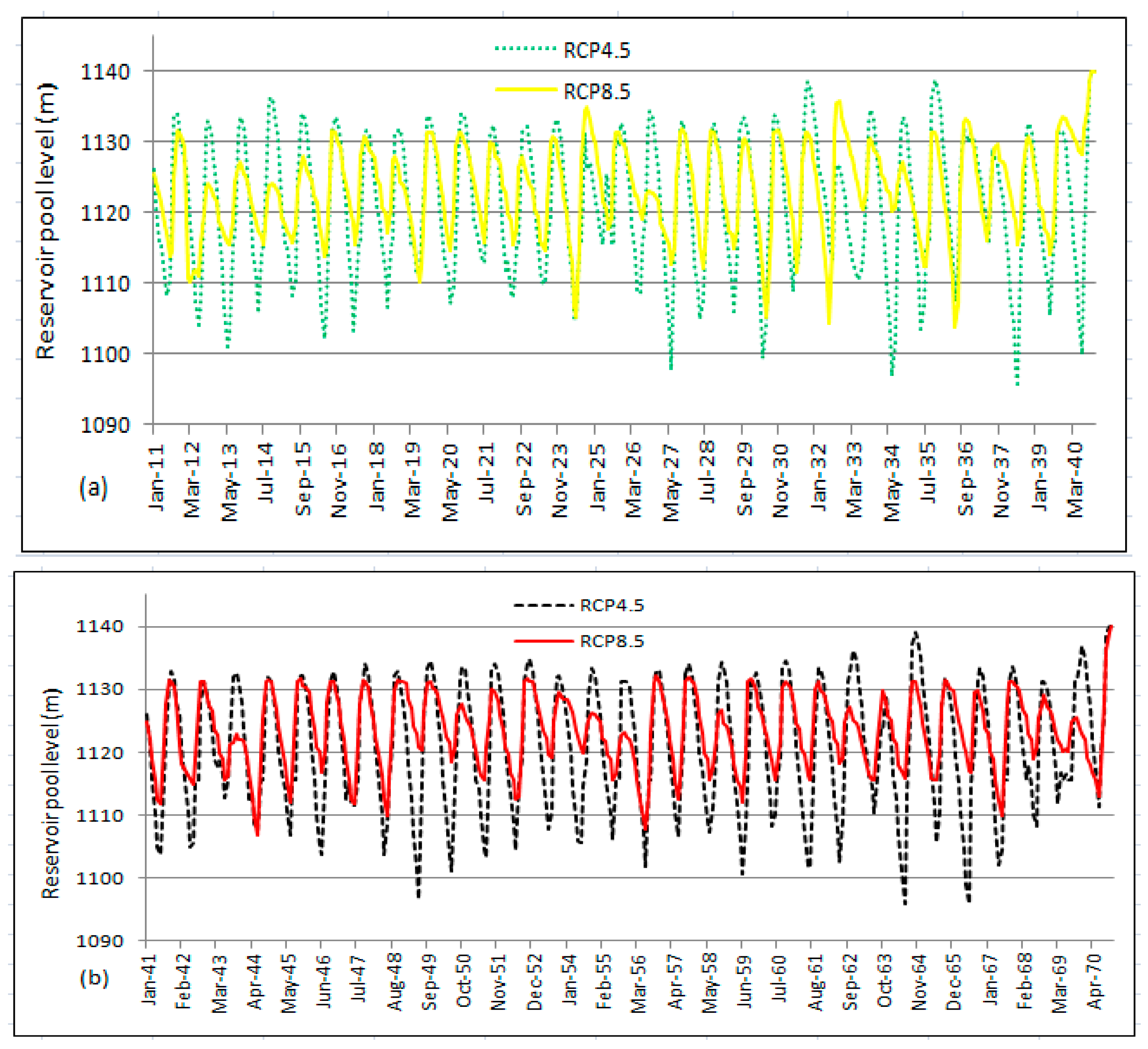
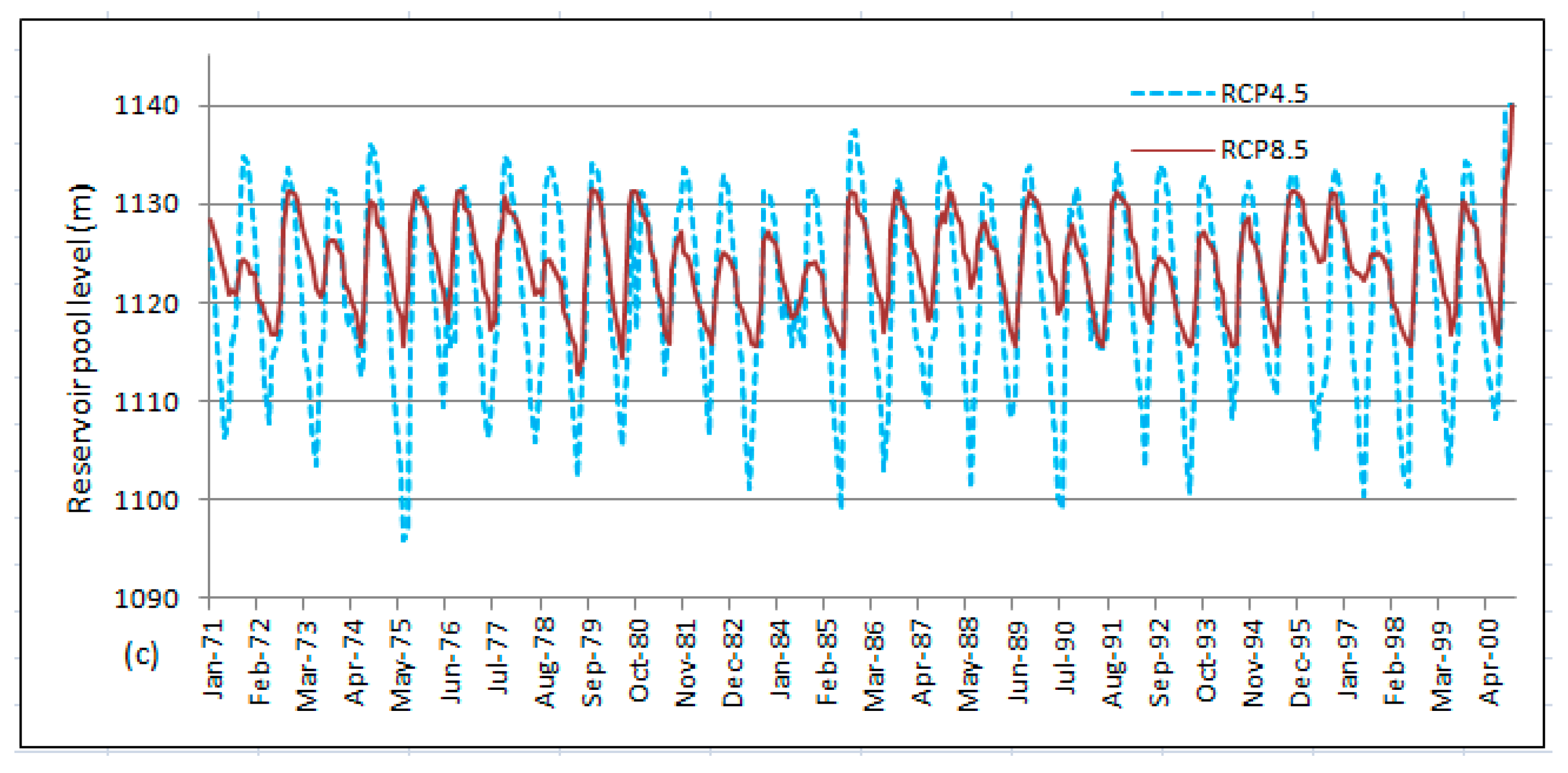
| Periods | Optimized Reservoir Storage (Mm3) | Change in Optimized Reservoir Storage (%) | ||
|---|---|---|---|---|
| RCP4.5 | RCP8.5 | RCP4.5 | RCP8.5 | |
| Current optimized | 6639 | 24.0 | ||
| 2020s | 6688 | 6880 | 25.0 | 28.5 |
| 2050s | 6669 | 6903 | 24.6 | 29.0 |
| 2080s | 6665 | 6958 | 24.5 | 30.0 |
| Time Periods | Optimized Pool Level (masl) | Pool Level Change (m) | ||
|---|---|---|---|---|
| RCP4.5 | RCP8.5 | RCP4.5 | RCP8.5 | |
| Current optimized | 1120.48 | 7.87 | ||
| 2020s | 1121.06 | 1123.27 | 8.45 | 10.66 |
| 2050s | 1120.87 | 1123.37 | 8.26 | 10.76 |
| 2080s | 1120.89 | 1123.85 | 8.28 | 11.24 |
© 2018 by the authors. Licensee MDPI, Basel, Switzerland. This article is an open access article distributed under the terms and conditions of the Creative Commons Attribution (CC BY) license (http://creativecommons.org/licenses/by/4.0/).
Share and Cite
Abera, F.F.; Asfaw, D.H.; Engida, A.N.; Melesse, A.M. Optimal Operation of Hydropower Reservoirs under Climate Change: The Case of Tekeze Reservoir, Eastern Nile. Water 2018, 10, 273. https://doi.org/10.3390/w10030273
Abera FF, Asfaw DH, Engida AN, Melesse AM. Optimal Operation of Hydropower Reservoirs under Climate Change: The Case of Tekeze Reservoir, Eastern Nile. Water. 2018; 10(3):273. https://doi.org/10.3390/w10030273
Chicago/Turabian StyleAbera, Fikru Fentaw, Dereje Hailu Asfaw, Agizew Nigussie Engida, and Assefa M. Melesse. 2018. "Optimal Operation of Hydropower Reservoirs under Climate Change: The Case of Tekeze Reservoir, Eastern Nile" Water 10, no. 3: 273. https://doi.org/10.3390/w10030273
APA StyleAbera, F. F., Asfaw, D. H., Engida, A. N., & Melesse, A. M. (2018). Optimal Operation of Hydropower Reservoirs under Climate Change: The Case of Tekeze Reservoir, Eastern Nile. Water, 10(3), 273. https://doi.org/10.3390/w10030273






